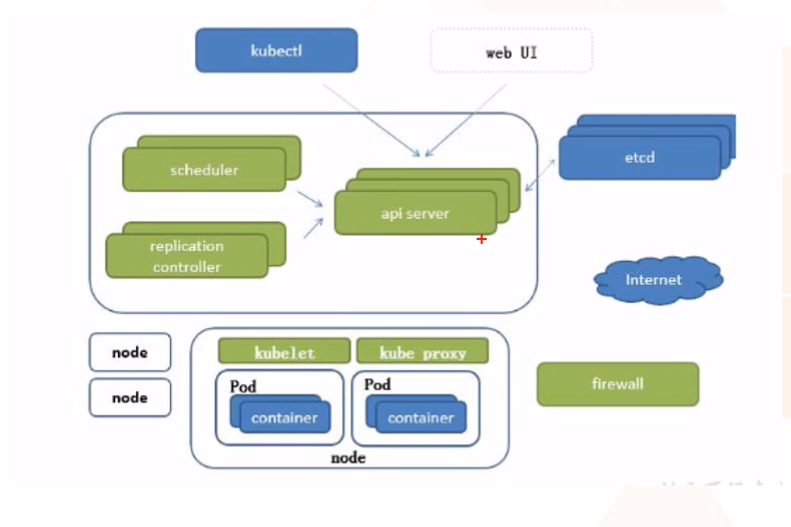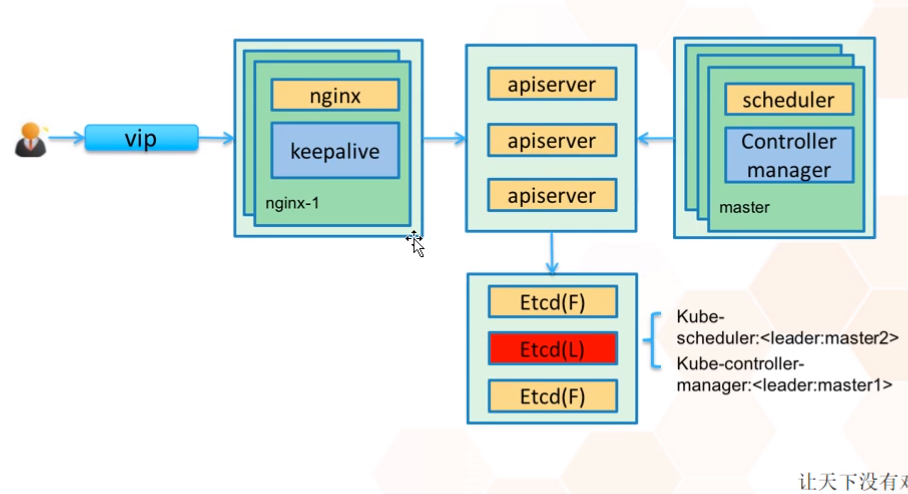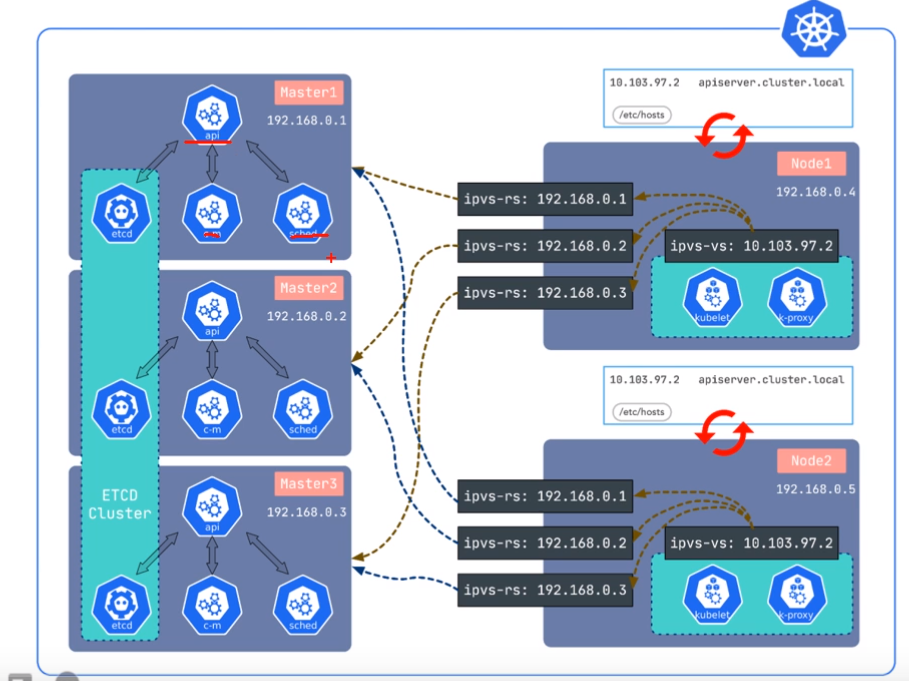K8S-Sealos部署高可用集群
理论部分
传统高可用部署
使用nginx/LVS/haproxy代理,实现高可用


Sealos部署高可用原理
以下架构,如果在三个master节点前面部署了负载均衡,那么只需要将APIServer地址代理即可,scheduler和controller manager不需要执行负载均衡,因为如果APIServer挂了,调度器和控制器去访问负载均衡访问不到会报错;只需要使用回环接口访问APIServer,当某一个APIServer挂了,那么这两个组件也挂了;pod不受影响。
kubernetes和kuber-proxy 由IPVS生成路由规则,通过访问域名apiserver.cluster.local解析到10.103.97.2,转发到master节点,但是IPVS是没有健康检测的,当某一台master宕机,那么会有33%几率失败,所以k8s高版本使用pod实时监控master节点状态,当某一台宕机,自动移除路由规则。
kubectl 配置/etc/hosts文件指定当前所在的APIServer node节点的IP即可。比如:192.168.0.1 apiserver.cluster.local

开始搭建
环境准备
3台master,master必须要是奇数,因为要选举
2台node节点
节点初始化
设置系统主机名以及 Host 文件的相互解析
hostnamectl set-hostname k8s-master01
安装依赖包
yum install -y conntrack ntpdate ntp ipvsadm ipset iptables curl sysstat libseccomp wget vim net-tools git
设置防火墙为 Iptables 并设置空规则
systemctl stop firewalld && systemctl disable firewalld
yum -y install iptables-services && systemctl start iptables && systemctl enable iptables && iptables -F && service iptables save
关闭 SELINUX
swapoff -a && sed -i '/ swap / s/^\(.*\)$/#\1/g' /etc/fstab setenforce 0 && sed -i 's/^SELINUX=.*/SELINUX=disabled/' /etc/selinux/config
调整内核参数,对于 K8S
cat > kubernetes.conf <<EOF net.bridge.bridge-nf-call-iptables=1 net.bridge.bridge-nf-call-ip6tables=1 net.ipv4.ip_forward=1 net.ipv4.tcp_tw_recycle=0 vm.swappiness=0 禁止使用 swap 空间,只有当系统 OOM 时才允许使用它 vm.overcommit_memory=1 不检查物理内存是否够用 vm.panic_on_oom=0 开启 OOM fs.inotify.max_user_instances=8192 fs.inotify.max_user_watches=1048576 fs.file-max=52706963 fs.nr_open=52706963 net.ipv6.conf.all.disable_ipv6=1 net.netfilter.nf_conntrack_max=2310720 EOF
cp kubernetes.conf /etc/sysctl.d/kubernetes.conf
sysctl -p /etc/sysctl.d/kubernetes.conf
调整系统时区
设置系统时区为 中国/上海 timedatectl set-timezone Asia/Shanghai 将当前的 UTC 时间写入硬件时钟 timedatectl set-local-rtc 0 重启依赖于系统时间的服务 systemctl restart rsyslog systemctl restart crond
关闭系统不需要服务
systemctl stop postfix && systemctl disable postfix
设置 rsyslogd 和 systemd journald
mkdir /var/log/journal 持久化保存日志的目录 mkdir /etc/systemd/journald.conf.d
cat > /etc/systemd/journald.conf.d/99-prophet.conf <<EOF [Journal] 持久化保存到磁盘 Storage=persistent 压缩历史日志 Compress=yes SyncIntervalSec=5m RateLimitInterval=30s RateLimitBurst=1000 最大占用空间 10G SystemMaxUse=10G 单日志文件最大 200M SystemMaxFileSize=200M 日志保存时间 2 周 MaxRetentionSec=2week 不将日志转发到 syslog ForwardToSyslog=no EOF
重启服务
systemctl restart systemd-journald
升级系统内核为 4.44
CentOS 7.x 系统自带的 3.10.x 内核存在一些 Bugs,导致运行的 Docker、Kubernetes 不稳定
rpm -Uvh http://www.elrepo.org/elrepo-release-7.0-3.el7.elrepo.noarch.rpm
安装完成后检查 /boot/grub2/grub.cfg 中对应内核 menuentry 中是否包含 initrd16 配置,如果没有,再安装一次!
]# cat /boot/grub2/grub.cfg |grep initrd16 initrd16 /boot/initramfs-0-rescue-262c28bb9aba48a0ad5294749a4fddaa.img initrd16 /boot/initramfs-4.4.222-1.el7.elrepo.x86_64.img initrd16 /boot/initramfs-3.10.0-1160.45.1.el7.x86_64.img initrd16 /boot/initramfs-0-rescue-21acf41b46a64ca4a55e93cb350a7749.img
设置开机从新内核启动
grub2-set-default 'CentOS Linux (4.4.189-1.el7.elrepo.x86_64) 7 (Core)'
kube-proxy开启ipvs的前置条件
cat > /etc/sysconfig/modules/ipvs.modules <<EOF #!/bin/bash modprobe -- ip_vs modprobe -- ip_vs_rr modprobe -- ip_vs_wrr modprobe -- ip_vs_sh modprobe -- nf_conntrack_ipv4 EOF
chmod 755 /etc/sysconfig/modules/ipvs.modules && bash /etc/sysconfig/modules/ipvs.modules && lsmod | grep -e ip_vs -e nf_conntrack_ipv4
Sealos
官网文档:https://www.sealyun.com/instructions/1st
下载并安装 sealos, sealos 是个 golang 的二进制工具,直接下载拷贝到 bin 目录即可, release 页面也可下载
wget -c https://sealyun.oss-cn-beijing.aliyuncs.com/latest/sealos && chmod +x sealos && mv sealos /usr/bin



